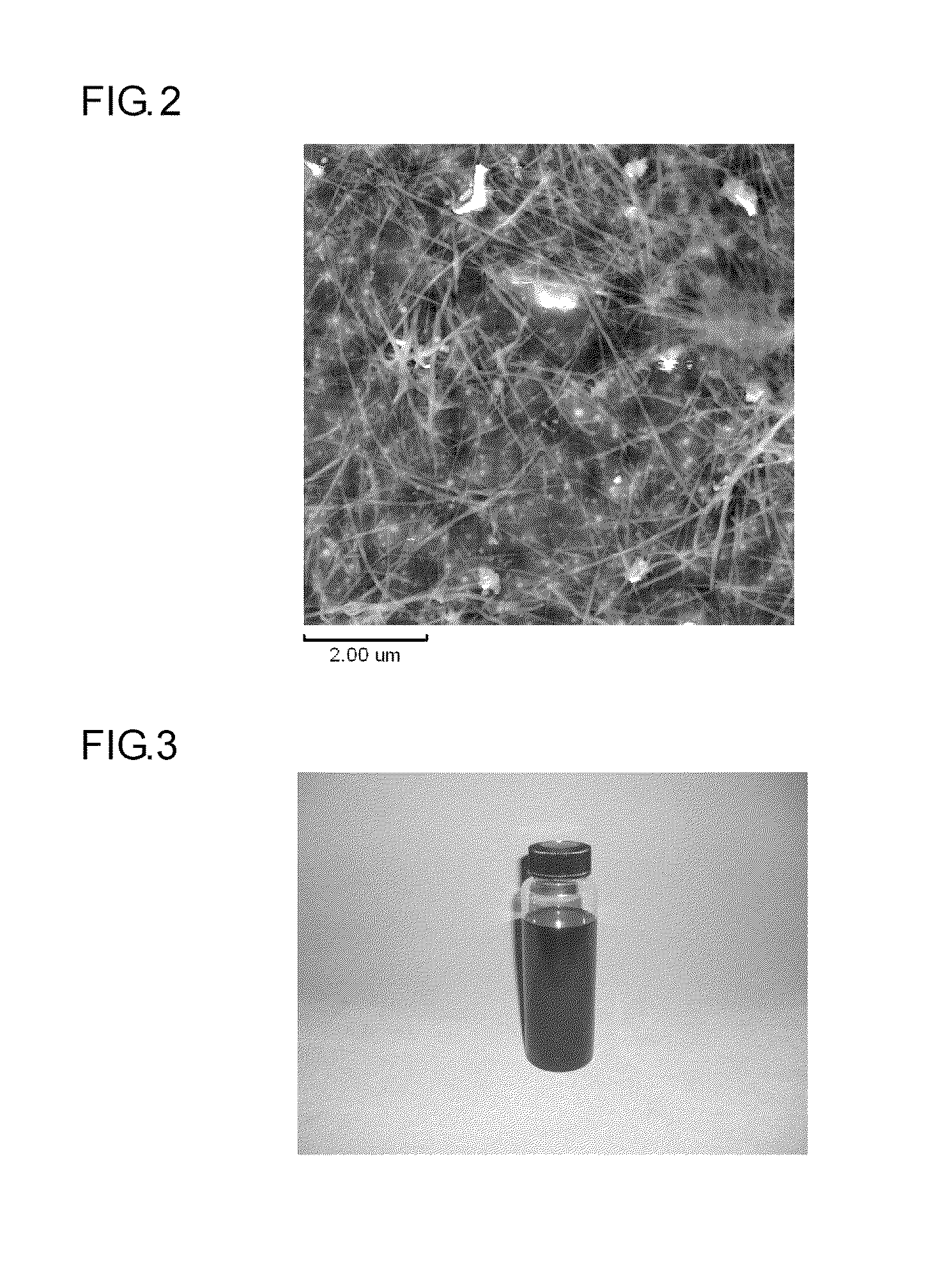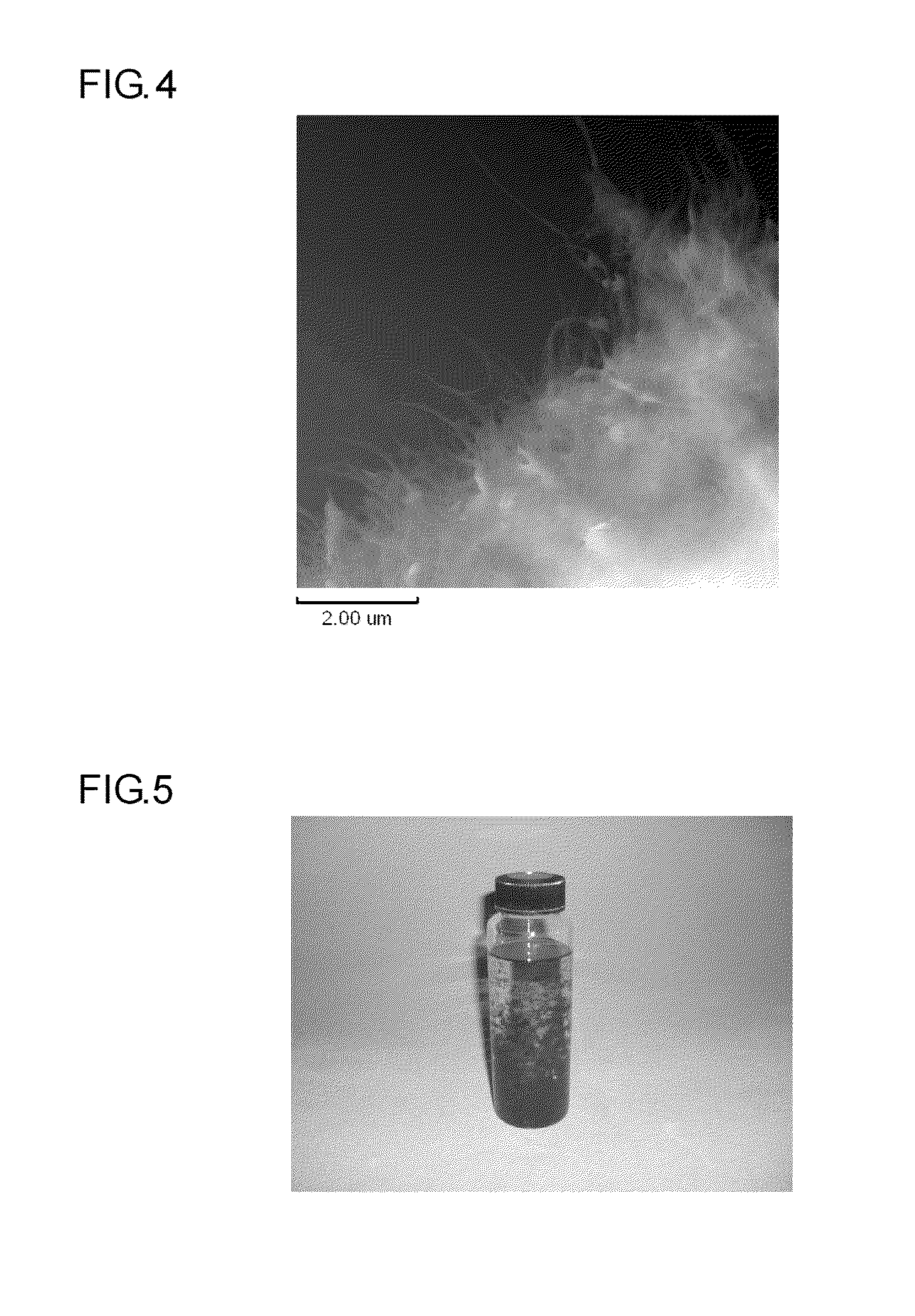Carbon nanotube dispersion and utilization of same
a technology of carbon nanotubes and dispersed carbon, which is applied in the direction of transportation and packaging, layered products, chemistry apparatus and processes, etc., can solve the problems of high volatile lower alcohols having 1 to 4 carbon atoms and the dispersion of carbon nanotubes in organic solvents, and achieve the suppression of excessive fragmentation and damage to carbon nanotubes.
- Summary
- Abstract
- Description
- Claims
- Application Information
AI Technical Summary
Benefits of technology
Problems solved by technology
Method used
Image
Examples
experimental example 1
[0071]A carbon nanotube dispersion was produced according to the procedure shown in FIG. 1. First, carbon nanotube aggregates were prepared by various methods (such as arc discharge) for use as a raw material (Step S1). In the present experimental example, the carbon nanotube aggregates were prepared in the manner described below.
[0072]Namely, a pair of stick-shaped electrodes (cathode and anode) were prepared that were composed of graphite-containing iron (0.5 mol % to 5 mol %), and the electrodes were arranged in mutual opposition in a reaction vessel at a spacing of about 0.5 mm to 5 mm. The inside of the reaction vessel was adjusted to an atmosphere at a hydrogen gas (H2) partial pressure of 1.3×104 Pa and an inert gas (in this case, argon (Ar)) partial pressure of about 1.3×104 Pa. A voltage of about 20 V to 40 V was applied between the pair of electrodes from a direct current power supply, a current of about 30 A to 70 A was supplied from the power supply, and an arc discharge...
experimental example 2
[0080]Next, a liquid medium not containing polyvinyl butyral resin was prepared (namely, a liquid medium containing only ethanol). A carbon nanotube dispersion was produced in the same manner as Experimental Example 1 with the exception of not containing polyvinyl butyral resin as described above. As a result, although carbon nanotube aggregates were initially dispersed in the resulting dispersion, they soon settled and a dispersed state was unable to be maintained. An SPM micrograph of this dispersion is shown in FIG. 4, while an optical photograph thereof is shown in FIG. 5.
experimental example 3
[0081]Next, the ethanol used for the alcohol solvent in the liquid medium was changed to commercially-available absolute methanol (purity: 99.9%). A carbon nanotube dispersion was produced in the same manner as Experimental Example 1 with the exception of using the above-mentioned methanol instead of ethanol. The resulting dispersion was then allowed to stand undisturbed. An optical photograph of the dispersion after being allowed to stand undisturbed for 2 weeks is shown in FIG. 6. As is clear from this micrograph, there was no settling of carbon nanotube aggregates and a satisfactory dispersed state was confirmed to be maintained even after being allowed to stand undisturbed for 2 weeks.
PUM
| Property | Measurement | Unit |
|---|---|---|
| weight ratio | aaaaa | aaaaa |
| weight ratio | aaaaa | aaaaa |
| viscosity | aaaaa | aaaaa |
Abstract
Description
Claims
Application Information
 Login to View More
Login to View More - R&D
- Intellectual Property
- Life Sciences
- Materials
- Tech Scout
- Unparalleled Data Quality
- Higher Quality Content
- 60% Fewer Hallucinations
Browse by: Latest US Patents, China's latest patents, Technical Efficacy Thesaurus, Application Domain, Technology Topic, Popular Technical Reports.
© 2025 PatSnap. All rights reserved.Legal|Privacy policy|Modern Slavery Act Transparency Statement|Sitemap|About US| Contact US: help@patsnap.com



